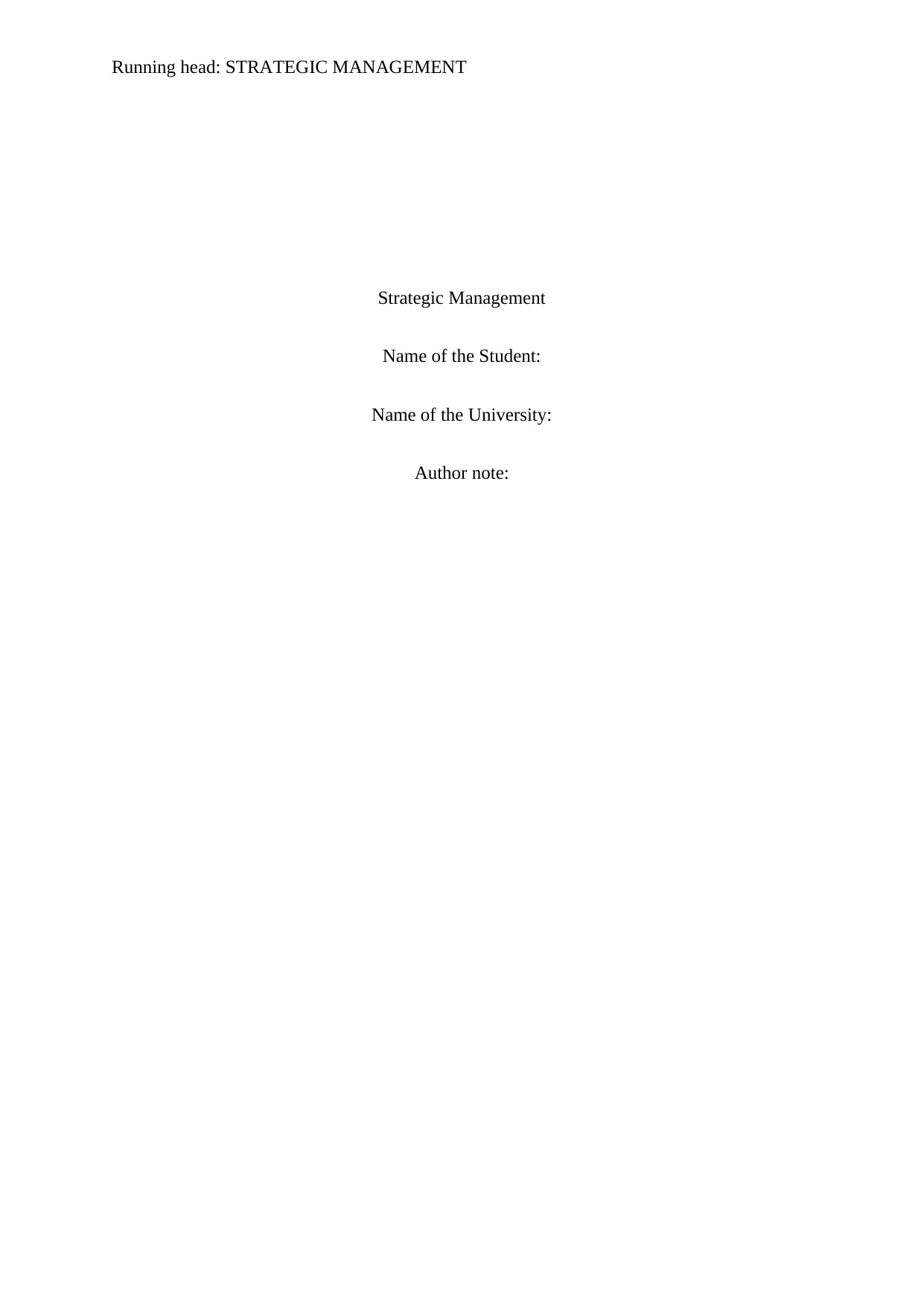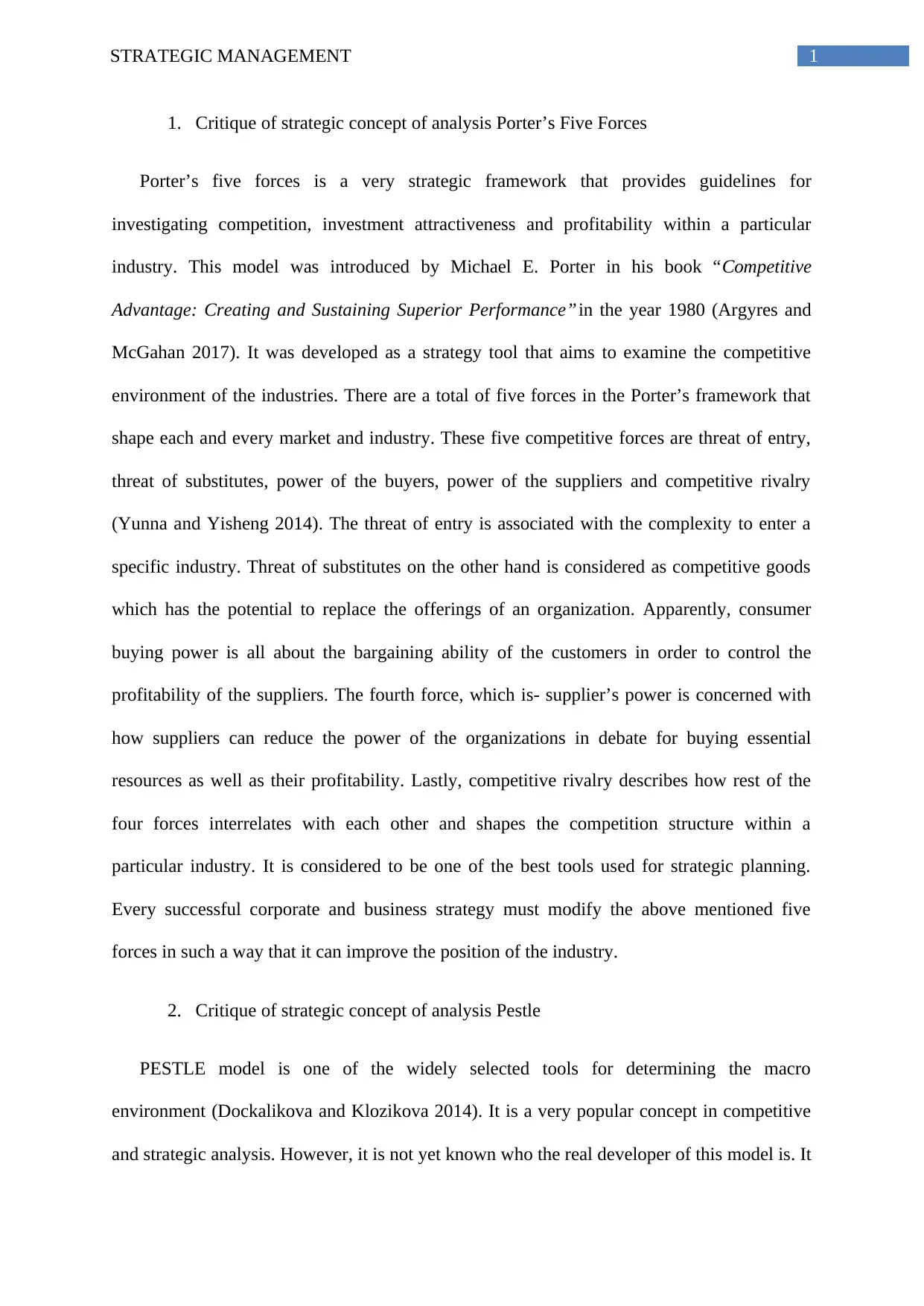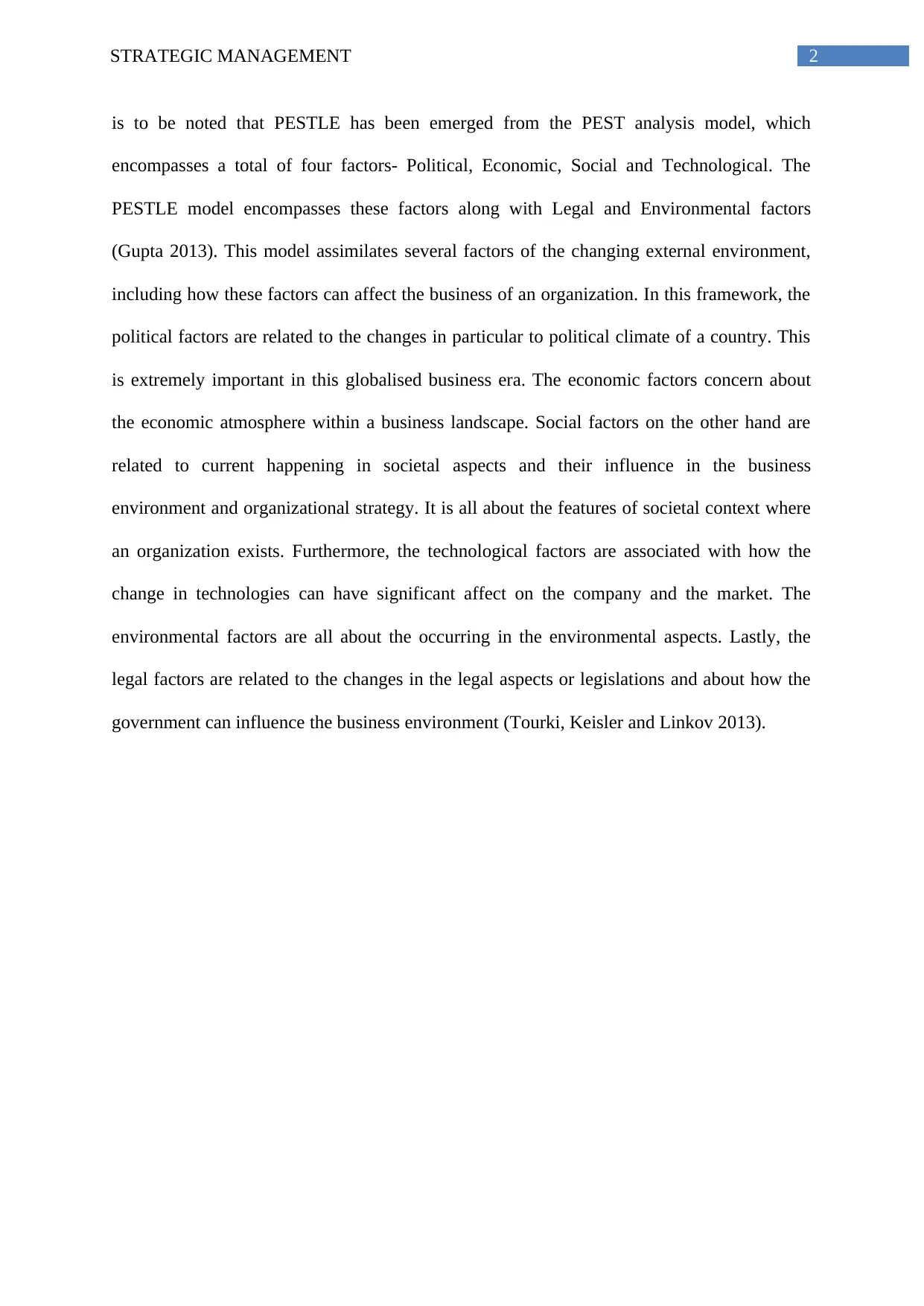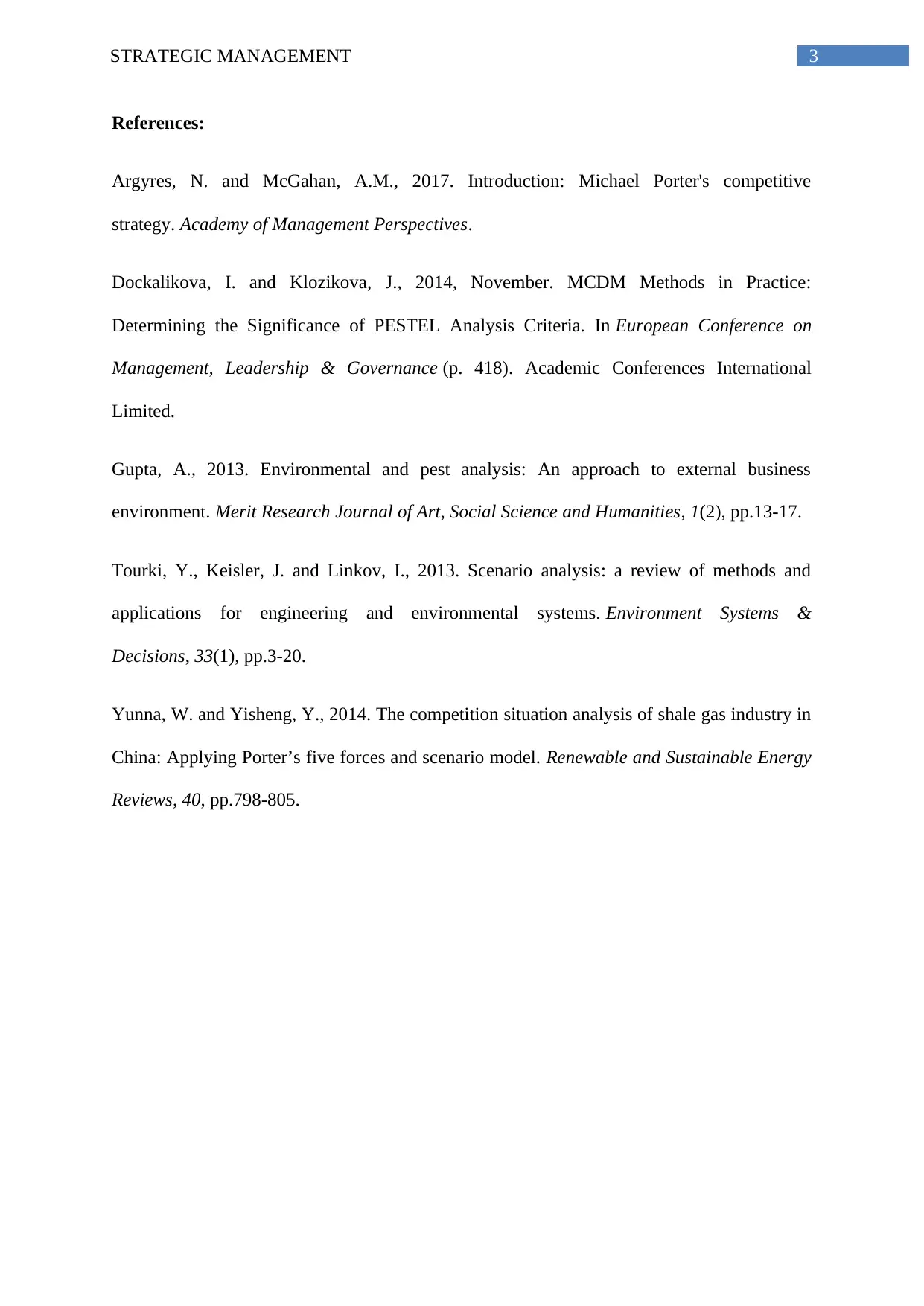Strategic Analysis Critique: Porter's Five Forces and PESTLE Framework
VerifiedAdded on 2023/06/14
|4
|807
|296
Essay
AI Summary
This essay presents a critical analysis of two prominent strategic management tools: Porter's Five Forces and the PESTLE model. It begins by outlining Porter's Five Forces framework, which examines industry competition based on the threat of new entrants, the threat of substitutes, the bargaining power of buyers and suppliers, and the intensity of competitive rivalry. The essay then transitions to a discussion of the PESTLE model, a tool used for macro-environmental analysis, encompassing political, economic, social, technological, environmental, and legal factors. The analysis considers the strengths and limitations of each model in the context of strategic decision-making and business planning.

Running head: STRATEGIC MANAGEMENT
Strategic Management
Name of the Student:
Name of the University:
Author note:
Strategic Management
Name of the Student:
Name of the University:
Author note:
Paraphrase This Document
Need a fresh take? Get an instant paraphrase of this document with our AI Paraphraser

1STRATEGIC MANAGEMENT
1. Critique of strategic concept of analysis Porter’s Five Forces
Porter’s five forces is a very strategic framework that provides guidelines for
investigating competition, investment attractiveness and profitability within a particular
industry. This model was introduced by Michael E. Porter in his book “Competitive
Advantage: Creating and Sustaining Superior Performance”in the year 1980 (Argyres and
McGahan 2017). It was developed as a strategy tool that aims to examine the competitive
environment of the industries. There are a total of five forces in the Porter’s framework that
shape each and every market and industry. These five competitive forces are threat of entry,
threat of substitutes, power of the buyers, power of the suppliers and competitive rivalry
(Yunna and Yisheng 2014). The threat of entry is associated with the complexity to enter a
specific industry. Threat of substitutes on the other hand is considered as competitive goods
which has the potential to replace the offerings of an organization. Apparently, consumer
buying power is all about the bargaining ability of the customers in order to control the
profitability of the suppliers. The fourth force, which is- supplier’s power is concerned with
how suppliers can reduce the power of the organizations in debate for buying essential
resources as well as their profitability. Lastly, competitive rivalry describes how rest of the
four forces interrelates with each other and shapes the competition structure within a
particular industry. It is considered to be one of the best tools used for strategic planning.
Every successful corporate and business strategy must modify the above mentioned five
forces in such a way that it can improve the position of the industry.
2. Critique of strategic concept of analysis Pestle
PESTLE model is one of the widely selected tools for determining the macro
environment (Dockalikova and Klozikova 2014). It is a very popular concept in competitive
and strategic analysis. However, it is not yet known who the real developer of this model is. It
1. Critique of strategic concept of analysis Porter’s Five Forces
Porter’s five forces is a very strategic framework that provides guidelines for
investigating competition, investment attractiveness and profitability within a particular
industry. This model was introduced by Michael E. Porter in his book “Competitive
Advantage: Creating and Sustaining Superior Performance”in the year 1980 (Argyres and
McGahan 2017). It was developed as a strategy tool that aims to examine the competitive
environment of the industries. There are a total of five forces in the Porter’s framework that
shape each and every market and industry. These five competitive forces are threat of entry,
threat of substitutes, power of the buyers, power of the suppliers and competitive rivalry
(Yunna and Yisheng 2014). The threat of entry is associated with the complexity to enter a
specific industry. Threat of substitutes on the other hand is considered as competitive goods
which has the potential to replace the offerings of an organization. Apparently, consumer
buying power is all about the bargaining ability of the customers in order to control the
profitability of the suppliers. The fourth force, which is- supplier’s power is concerned with
how suppliers can reduce the power of the organizations in debate for buying essential
resources as well as their profitability. Lastly, competitive rivalry describes how rest of the
four forces interrelates with each other and shapes the competition structure within a
particular industry. It is considered to be one of the best tools used for strategic planning.
Every successful corporate and business strategy must modify the above mentioned five
forces in such a way that it can improve the position of the industry.
2. Critique of strategic concept of analysis Pestle
PESTLE model is one of the widely selected tools for determining the macro
environment (Dockalikova and Klozikova 2014). It is a very popular concept in competitive
and strategic analysis. However, it is not yet known who the real developer of this model is. It

2STRATEGIC MANAGEMENT
is to be noted that PESTLE has been emerged from the PEST analysis model, which
encompasses a total of four factors- Political, Economic, Social and Technological. The
PESTLE model encompasses these factors along with Legal and Environmental factors
(Gupta 2013). This model assimilates several factors of the changing external environment,
including how these factors can affect the business of an organization. In this framework, the
political factors are related to the changes in particular to political climate of a country. This
is extremely important in this globalised business era. The economic factors concern about
the economic atmosphere within a business landscape. Social factors on the other hand are
related to current happening in societal aspects and their influence in the business
environment and organizational strategy. It is all about the features of societal context where
an organization exists. Furthermore, the technological factors are associated with how the
change in technologies can have significant affect on the company and the market. The
environmental factors are all about the occurring in the environmental aspects. Lastly, the
legal factors are related to the changes in the legal aspects or legislations and about how the
government can influence the business environment (Tourki, Keisler and Linkov 2013).
is to be noted that PESTLE has been emerged from the PEST analysis model, which
encompasses a total of four factors- Political, Economic, Social and Technological. The
PESTLE model encompasses these factors along with Legal and Environmental factors
(Gupta 2013). This model assimilates several factors of the changing external environment,
including how these factors can affect the business of an organization. In this framework, the
political factors are related to the changes in particular to political climate of a country. This
is extremely important in this globalised business era. The economic factors concern about
the economic atmosphere within a business landscape. Social factors on the other hand are
related to current happening in societal aspects and their influence in the business
environment and organizational strategy. It is all about the features of societal context where
an organization exists. Furthermore, the technological factors are associated with how the
change in technologies can have significant affect on the company and the market. The
environmental factors are all about the occurring in the environmental aspects. Lastly, the
legal factors are related to the changes in the legal aspects or legislations and about how the
government can influence the business environment (Tourki, Keisler and Linkov 2013).
⊘ This is a preview!⊘
Do you want full access?
Subscribe today to unlock all pages.

Trusted by 1+ million students worldwide

3STRATEGIC MANAGEMENT
References:
Argyres, N. and McGahan, A.M., 2017. Introduction: Michael Porter's competitive
strategy. Academy of Management Perspectives.
Dockalikova, I. and Klozikova, J., 2014, November. MCDM Methods in Practice:
Determining the Significance of PESTEL Analysis Criteria. In European Conference on
Management, Leadership & Governance (p. 418). Academic Conferences International
Limited.
Gupta, A., 2013. Environmental and pest analysis: An approach to external business
environment. Merit Research Journal of Art, Social Science and Humanities, 1(2), pp.13-17.
Tourki, Y., Keisler, J. and Linkov, I., 2013. Scenario analysis: a review of methods and
applications for engineering and environmental systems. Environment Systems &
Decisions, 33(1), pp.3-20.
Yunna, W. and Yisheng, Y., 2014. The competition situation analysis of shale gas industry in
China: Applying Porter’s five forces and scenario model. Renewable and Sustainable Energy
Reviews, 40, pp.798-805.
References:
Argyres, N. and McGahan, A.M., 2017. Introduction: Michael Porter's competitive
strategy. Academy of Management Perspectives.
Dockalikova, I. and Klozikova, J., 2014, November. MCDM Methods in Practice:
Determining the Significance of PESTEL Analysis Criteria. In European Conference on
Management, Leadership & Governance (p. 418). Academic Conferences International
Limited.
Gupta, A., 2013. Environmental and pest analysis: An approach to external business
environment. Merit Research Journal of Art, Social Science and Humanities, 1(2), pp.13-17.
Tourki, Y., Keisler, J. and Linkov, I., 2013. Scenario analysis: a review of methods and
applications for engineering and environmental systems. Environment Systems &
Decisions, 33(1), pp.3-20.
Yunna, W. and Yisheng, Y., 2014. The competition situation analysis of shale gas industry in
China: Applying Porter’s five forces and scenario model. Renewable and Sustainable Energy
Reviews, 40, pp.798-805.
1 out of 4
Related Documents
Your All-in-One AI-Powered Toolkit for Academic Success.
+13062052269
info@desklib.com
Available 24*7 on WhatsApp / Email
![[object Object]](/_next/static/media/star-bottom.7253800d.svg)
Unlock your academic potential
Copyright © 2020–2025 A2Z Services. All Rights Reserved. Developed and managed by ZUCOL.




